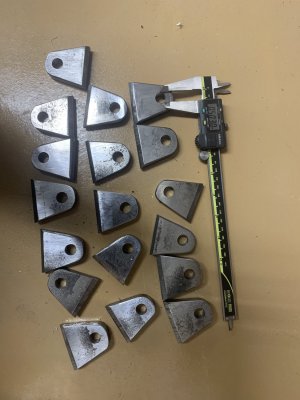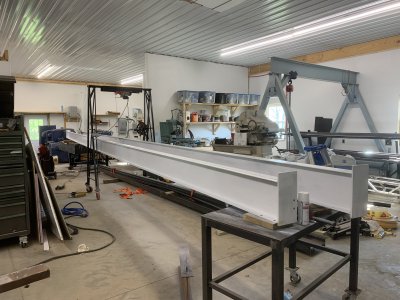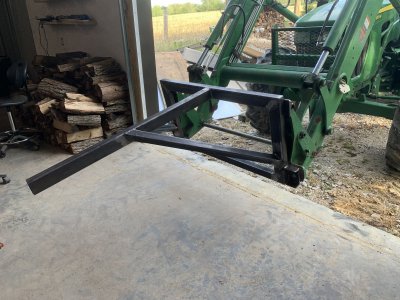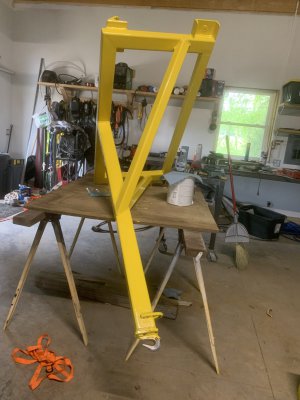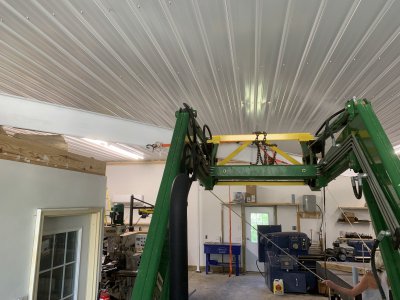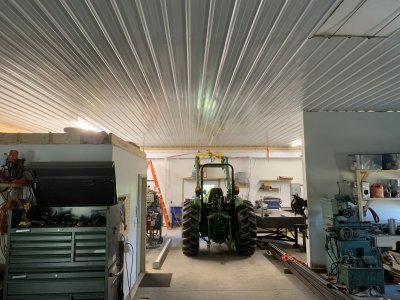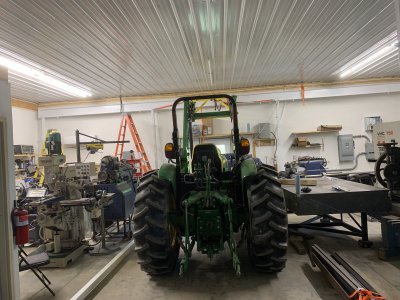- Joined
- Feb 25, 2021
- Messages
- 3,129
Bit of design trivia. Not my expertise so I'm sure those with ME/CE degrees or career experience could expound much better. But I'm bored and not up to much more than the computer, so I'm babbling.
In this image from above, you can see the 4 bolt holes along the lower edge of the truck, to bolt through into the retainer strip that keeps the truck captive on the rail. That retainer strip is just a safety, so it does not provide any structural function. Well, actuallly ...
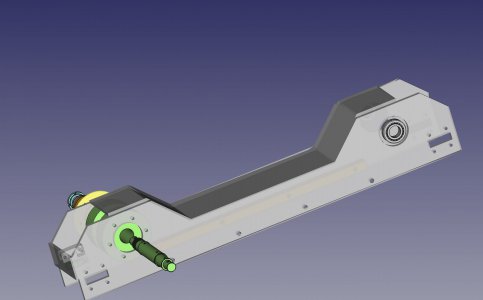
For a long horizontal beam supporting a weight, if you look at a force carried by the metal, it is highest at the edges of a piece. That means the metal fails from the outer edge inward. Pretty intuitive if you've seen anything crack. This is why I-beams or W-beams have most of the metal in the flange, put the majority of the metal in the flange where the force is carried. This reduces the stress in the metal, which is just force per unit area. Basically all designing comes down to keeping the maximum stress well below the threshold that the metal can carry. (How much it can carry, over time, factoring in possible fatigue, etc, is a VERY complex topic).
Figuring the stress in the metal is not simple. There are plenty of pre-computed numbers for basic shapes (called moments of inertia). If you remember back to high school science you may have studied "springs". If you are a geek, you might even remember "Hooke's Law", F=kx. Really all you need to do is a 3 dimensional integral (calculus) of Hooke's Law over the area of the loaded structure to see what stress is. Basically you treat the entire structure as if it was built of 3D interconnected springs. That's the foundation of this type of design work.
To deal with complex structures that 3D mesh of interconnected springs is modeled by a computer. This is the "Finite Element Analysis (FEA) @Dabbler and I discussed earlier. It is the only practical way to do a rigorous analysis of how the metal is carrying forces (or wood, or plastic, or complex composites). Necessary when designing airplanes, or bridges or skyscrapers, even car structures for that matter. I'm not doing that computer FEA. I'm using basic formulas for simple cross sections and going with that. One thing that requires is a good sense of where the metal is going to be most loaded. Most under stress. If you miss a highly loaded point that is quite possibly a structural failure. As in crane comes down catastrophically. I would guess most of us here working with metal have a bit better intuitive sense for some of those issues, but it's still educated guessing. Of course the houses we live in are structures that are designed with simple guidelines rather than FEA, so those guidelines, developed over enough time, are pretty good.
Back to those bolt holes that are along the bottom edge. If you have a 1/2" hole that is 3/4" from center to the bottom edge, that leaves 1/2" of metal beyond the hole. Because of the hole, the stress in that area goes to that outboard piece. So now that outboard piece is carrying very roughly twice the stress as it would without the hole, which makes it a prime location to start a stress crack. Moving the hole up by a mere .25", so that stress is carried by 3/4" instead of over 1/2". That extra metal implies instead of twice the load, it is only 33% more. And because the hole is farther from the highly stressed edge, it actually transfers a lot less stress. Of course, that FEA analysis would be the best way to get these numbers right, for this diatribe I'm just doing hand waving instead of real math!
Long way of saying after thinking about my design, I moved those holes up 1/4" for a significant structural improvement. Now, to really get complicated, when the retainer strip is bolted to the side plate it could help relieve some of the stress in the side plate. Basically a reinforcement buckler/gusset plate. But only if properly torqued and secured. I'm not counting on that. Because that requires careful thought to bolt torques and static friction and bolt tolerances in that model. Way too many assumptions!
In this image from above, you can see the 4 bolt holes along the lower edge of the truck, to bolt through into the retainer strip that keeps the truck captive on the rail. That retainer strip is just a safety, so it does not provide any structural function. Well, actuallly ...

For a long horizontal beam supporting a weight, if you look at a force carried by the metal, it is highest at the edges of a piece. That means the metal fails from the outer edge inward. Pretty intuitive if you've seen anything crack. This is why I-beams or W-beams have most of the metal in the flange, put the majority of the metal in the flange where the force is carried. This reduces the stress in the metal, which is just force per unit area. Basically all designing comes down to keeping the maximum stress well below the threshold that the metal can carry. (How much it can carry, over time, factoring in possible fatigue, etc, is a VERY complex topic).
Figuring the stress in the metal is not simple. There are plenty of pre-computed numbers for basic shapes (called moments of inertia). If you remember back to high school science you may have studied "springs". If you are a geek, you might even remember "Hooke's Law", F=kx. Really all you need to do is a 3 dimensional integral (calculus) of Hooke's Law over the area of the loaded structure to see what stress is. Basically you treat the entire structure as if it was built of 3D interconnected springs. That's the foundation of this type of design work.
To deal with complex structures that 3D mesh of interconnected springs is modeled by a computer. This is the "Finite Element Analysis (FEA) @Dabbler and I discussed earlier. It is the only practical way to do a rigorous analysis of how the metal is carrying forces (or wood, or plastic, or complex composites). Necessary when designing airplanes, or bridges or skyscrapers, even car structures for that matter. I'm not doing that computer FEA. I'm using basic formulas for simple cross sections and going with that. One thing that requires is a good sense of where the metal is going to be most loaded. Most under stress. If you miss a highly loaded point that is quite possibly a structural failure. As in crane comes down catastrophically. I would guess most of us here working with metal have a bit better intuitive sense for some of those issues, but it's still educated guessing. Of course the houses we live in are structures that are designed with simple guidelines rather than FEA, so those guidelines, developed over enough time, are pretty good.
Back to those bolt holes that are along the bottom edge. If you have a 1/2" hole that is 3/4" from center to the bottom edge, that leaves 1/2" of metal beyond the hole. Because of the hole, the stress in that area goes to that outboard piece. So now that outboard piece is carrying very roughly twice the stress as it would without the hole, which makes it a prime location to start a stress crack. Moving the hole up by a mere .25", so that stress is carried by 3/4" instead of over 1/2". That extra metal implies instead of twice the load, it is only 33% more. And because the hole is farther from the highly stressed edge, it actually transfers a lot less stress. Of course, that FEA analysis would be the best way to get these numbers right, for this diatribe I'm just doing hand waving instead of real math!
Long way of saying after thinking about my design, I moved those holes up 1/4" for a significant structural improvement. Now, to really get complicated, when the retainer strip is bolted to the side plate it could help relieve some of the stress in the side plate. Basically a reinforcement buckler/gusset plate. But only if properly torqued and secured. I'm not counting on that. Because that requires careful thought to bolt torques and static friction and bolt tolerances in that model. Way too many assumptions!
Last edited:


